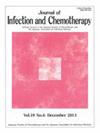Antimicrobial use in pediatric patients: a subgroup analysis of the 2020 point prevalence survey in Aichi, Japan
IF 1.5
4区 医学
Q3 INFECTIOUS DISEASES
引用次数: 0
Abstract
Background
Establishing the precise epidemiology of antimicrobial use (AMU) is essential to promote antimicrobial stewardship. However, data on AMU for pediatric inpatients in Japanese hospitals are lacking. In this study, we performed a subgroup analysis focusing on pediatric patients from a point prevalence survey.
Methods
A multicenter point prevalence survey was conducted in Aichi Prefecture in 2020. This subgroup analysis included pediatric patients (≦18 years old) and assessed AMU and their indications: community-acquired infections (CAIs), healthcare-associated infections (HAIs), medical prophylaxis (MP), and surgical prophylaxis (SP). Details of infections and interventions by the antimicrobial stewardship teams (AST) were also surveyed.
Results
Of the 736 patients from 23 hospitals included in this study, 241 patients (32.7 %, 95 % confidence interval [95 % CI]: 29.4–36.3) received a total of 399 antimicrobials. The prevalence of HAI was 6.0 % (95 % CI: 4.4–7.9). The number of antimicrobials administered per 100 patients ranged from 24.1 in small hospitals to 109.6 in university hospitals. CAI treatment was the most common indication in community hospitals, SP in specific centers, and MP in university hospitals. The most commonly prescribed antimicrobials were cefotaxime for CAI, meropenem for HAI, trimethoprim-sulfamethoxazole for MP, and cefazolin for SP. A total of 78 CAIs and 46 HAIs were identified, with AST intervention rates of 2.5 % and 34.8 %, respectively.
Conclusion
This subgroup analysis provides the first demographic data on AMU among pediatric inpatients at Japanese hospitals. The distinct distribution of AMU suggests that different approaches are necessary to promote antimicrobial stewardship in hospital settings.
儿科患者抗菌药物使用:日本爱知县2020年点状流行病学调查的亚组分析
背景:建立准确的抗菌药物使用流行病学(AMU)对促进抗菌药物管理至关重要。然而,日本医院儿科住院患者的AMU数据缺乏。在这项研究中,我们进行了亚组分析,重点是儿科患者从一个点患病率调查。方法:2020年在爱知县开展多中心点流行病学调查。该亚组分析纳入儿童患者(≤18岁),评估AMU及其适应证:社区获得性感染(CAIs)、医疗保健相关感染(HAIs)、医疗预防(MP)和手术预防(SP)。还调查了感染的细节和抗菌素管理小组(AST)的干预措施。结果:本研究纳入24家医院的736例患者中,有241例患者(32.7%,95%可信区间[95% CI]: 29.4-36.3)共使用了399种抗菌素。HAI患病率为6.0% (95% CI: 4.4-7.9)。每100名患者使用的抗菌剂数量从小医院的24.1到大学医院的109.6不等。CAI治疗是社区医院最常见的指征,专科医院为SP,大学医院为MP。最常用的抗菌药是治疗CAI的头孢噻肟、治疗HAI的美罗培南、治疗MP的甲氧苄啶-磺胺甲新唑和治疗SP的头孢唑林。共发现78例CAIs和46例HAIs, AST干预率分别为2.5%和34.8%。结论:该亚组分析首次提供了日本医院儿科住院患者AMU的人口统计数据。抗菌素的独特分布表明,需要采取不同的方法来促进医院环境中的抗菌素管理。
本文章由计算机程序翻译,如有差异,请以英文原文为准。
求助全文
约1分钟内获得全文
求助全文
来源期刊

Journal of Infection and Chemotherapy
INFECTIOUS DISEASES-PHARMACOLOGY & PHARMACY
CiteScore
4.10
自引率
4.50%
发文量
303
审稿时长
47 days
期刊介绍:
The Journal of Infection and Chemotherapy (JIC) — official journal of the Japanese Society of Chemotherapy and The Japanese Association for Infectious Diseases — welcomes original papers, laboratory or clinical, as well as case reports, notes, committee reports, surveillance and guidelines from all parts of the world on all aspects of chemotherapy, covering the pathogenesis, diagnosis, treatment, and control of infection, including treatment with anticancer drugs. Experimental studies on animal models and pharmacokinetics, and reports on epidemiology and clinical trials are particularly welcome.
 求助内容:
求助内容: 应助结果提醒方式:
应助结果提醒方式:


